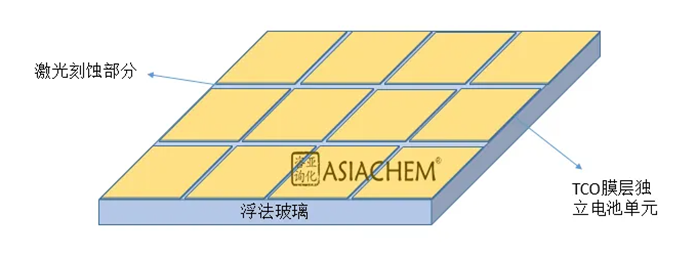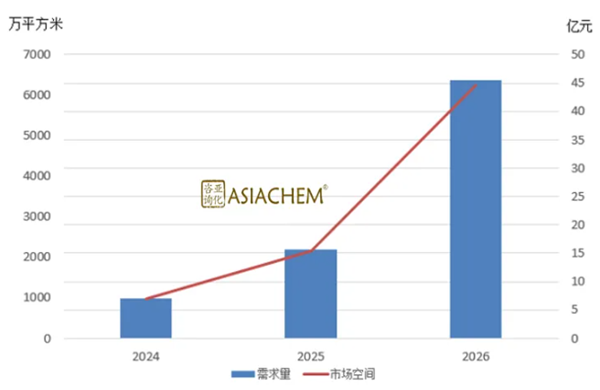Transparent conductive oxide (TCO) film plated glass is a film product of high transmission (>80%) invisible light band, high reflectivity in infrared zone, and lower than 1×10-3Ω·cm resistance.
TCO conductive theory: by blending trace quantity of other elements in the intrinsic semiconductor originally of very weak conductivity, to obtain so-called doped semiconductor, with improved conductive performance.
As the semiconductor layer in amorphous silicon film solar cell is hardly conductive laterally, TCO glass must be used as a prior placed stage to effectively collect cell current, so as to become an indispensable part in perovskite cell. Perovskite mono-junction cell is made from transparent glass plate and needs to use light transmittable electrode at the bottom layer, thus the TCO film plated glass can be directly used as the base, i.e. a glass panel plated with TCO film on the surface. The industry is quite matured, having suppliers both in China and abroad. Main materials for the use are in general indium tin oxide(ITO) or fluorine doped tin oxide (FTO) conductive glass.

Commonly available TCO materials: TCO films mainly include machine composited In/Sb/Zn/Sn/Cd multicomponent oxides.
TCO glass can be prepared in different ways based on various conductive raw materials:
1) ITO, tin doped indium oxide film (In2O3:Sn), enjoying matured production process, good light transmission and electric conductivity, but suffering from higher cost of the PVD process needing the use of rare metal indium.
2) FTO, fluorine doped tin dioxide film (SnO2:F), mostly used in film cell, industrially prepared mainly by an online CVD process of lower material cost comparing to ITO, and can be produced in bulk to realize high speed.
3) AZO, aluminum doped zinc oxide (ZnO:Al), featuring of good light transmission and electric conductivity, but so far is difficult to apply in bulk production and some issues remain in the process flow to hinder it becoming the mainstream. It is prepared mainly by PVD process.
Table Comparison between Common TCO Film-Plated Glass Products
Preparing manner | Online film plating | Offline film plating |
Mainstream process | CVD | PVD |
Target Material | FTO | ITO、AZO |
Coating process principle | To complete the coating process directly in the cooling of the float process line. The TCO raw material is transported in gaseous form above the glass plate and diffuses to glass surface under high-temp. After adsorption and chemical decomposition, the film layer is synthesized and deposited. | The ultra-white float glass is cleaned and preheated using magnetron sputtering technology, which uses ion bombardment of the target material in vacuum to escape molecules or atoms from the target material and deposit them on glass substrate surface to form a thin film. Then, it will be cooled and etched to complete the coating process |
Advantages | Chemical composition and structure of the film layer are relatively stable: a diffusion layer is easily formed between the substrate and the film layer, so thst the film is firm and adaptable; The coating process is integrated into the glass forming, resulting in higher productivity, | Convenient control of process parameters, i.e. accurate film thickness and uniformity, and high flexibility; modular design of coating equipment, easy to adjust the capacity; the sedimentary layer is obtained under vacuum to achieve high purity of the film layer |
disadvantages | Difficult to control the process parameters so that the film layer quality control tests the technical capabilities of manufacturers; difficulty to renovate the original raw sheet process line as no space is reserved for the coating equipment | High equipment price, complex process flow, low efficiency, and high overall process cost |
Chinese TCO glass production is at an initial stage, in general chooses FTO as the film layer material, and hence prepared in CVD process. Online chemical vapor deposition (CVD) film coating process is typically realized by installing the coating equipment at the cool end of the tin sink or before the annealing kiln in the floating process line, to use the continuously produce high-temp (400~700℃), clean and fast drawn glass tape as the carrier, through the chemical reaction of raw material gas (precursor) on high temp glass surface to synthesize the coating film, and afterward form a solid film layer by annealing and cooling. CVD working principle is to use thermal or plasma emitted energy to cause chemical reaction of gaseous raw material precursor (TCO) on solid (glass) surface and deposit on solid surface to form the film.
On the TCO glass top electrode in perovskite cell, FTO is the mainstream choice for commercial application. ITO has been widely applied as the transparent conductive electrode in LCD, OLED and similar monitor & contact control devices, and also been used as the top electrode material in earlier perovskite cell owing to its good conductivity and transmission. But its laser etching ability and light scattering ability are rather poor, and the price is nearly twice that of FTO glass.
FTO is fluorine doped SnO2 and, although not as good as ITO in conductivity and transmission, the advantages of the cost, process performance and comprehensive optical properties make it mostly fit to the use as the top electrode TCO glass in commercial uses. AZO is aluminum doped ZnO transparent and conductive glass, featuring of the advantages of low cost and better optical performance. However, as restricted by the material processing performance, it is hard to popularize, mainly because of the poor laser engraving performance, lack of high temp resistance, and susceptible to moisture and oxidation. If these problems are solved in future, the material would show potential to replace FTO.
TCO glass is the most certain use field of perovskite material, whilst even the most widely used FTO glass has only been applied in film cell. With the increasing output of perovskite cells, it is expected that the marginal growth will be the most significant. At present, TCO glass in perovskite field is mainly purchased from glass producers. Based on a PV conversion efficiency of 18%, 1GW of perovskite requires approximately 5.5mnm2 of TCO glass; from the perspective of the perovskite producer supply side, taking CNY70/m2 as price basis for calculation according to producer published data, and combined with previous prediction of ASIACHEM, the perovskite industry is expected to bring a demand of over 150mnm2/a by 2025.
